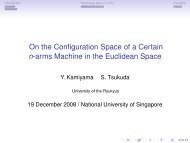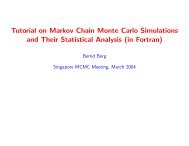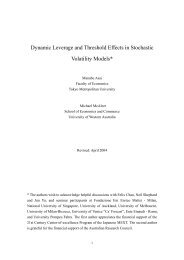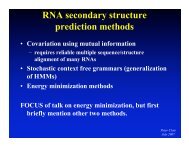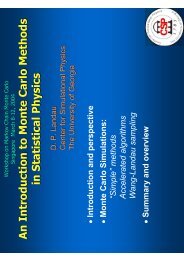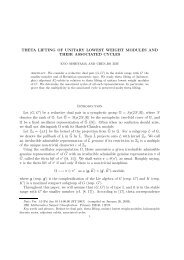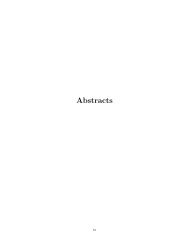Stein's method, Malliavin calculus and infinite-dimensional Gaussian
Stein's method, Malliavin calculus and infinite-dimensional Gaussian
Stein's method, Malliavin calculus and infinite-dimensional Gaussian
Create successful ePaper yourself
Turn your PDF publications into a flip-book with our unique Google optimized e-Paper software.
10.3 A non-central limit theorem (with bounds)<br />
We now present (without proofs) two statements concerning the Gamma approximation of multiple<br />
integrals of even order q 2. The …rst result, which is taken from [57], provides an explcit<br />
representation for the quantities appearing on the RHS of (9.11) <strong>and</strong> (9.12).<br />
Proposition 10.4 (See [57]) Let q 2 be an even integer, <strong>and</strong> let G = I q (g), where g 2 H q .<br />
Then,<br />
where<br />
E[(2 + 2G hDG; DL 1 Gi H ) 2 ] = E[(2 + 2G q 1 kDGk 2 H )2 ] (10.15)<br />
(2 q! kgk 2 H q)2 +<br />
+q 2 X<br />
1<br />
c q =<br />
(q=2)!<br />
q 1<br />
q=2 1<br />
r2f1;:::;q 1g<br />
r6=q=2<br />
4<br />
2<br />
=<br />
(q=2)!<br />
q 1 4<br />
(2q 2r)!(r 1)! 2 kg r gk 2 +<br />
r 1<br />
H 2(q r)<br />
q<br />
q=2<br />
+4q! c 1<br />
q g e q=2 g g 2 H q ;<br />
2<br />
: (10.16)<br />
The next statement, which is a main result of [56], contains a “non-central” analogous of<br />
Theorem 10.1. Recall the de…nition of the centered Gamma r<strong>and</strong>om variables F (), > 0,<br />
given in (8.2).<br />
Theorem 10.3 (See [56]) Fix > 0, as well as an even integer q 2. De…ne c q as in (10.16).<br />
Then, for any sequence ff k g k1 H q verifying<br />
lim q!kf kk 2 H<br />
= lim E I<br />
k!1 n q (f k ) 2 = Var (F ()) = 2; (10.17)<br />
k!1<br />
the following six conditions are equivalent:<br />
(i) lim k!1 E[I q (f k ) 3 ] = E[F () 3 ] = 8 <strong>and</strong> lim k!1 E[I q (f k ) 4 ] = E[F () 4 ] = 48 + 12 2 ;<br />
(ii) lim k!1 E[I q (f k ) 4 ] 12E[I q (f k ) 3 ] = 12 2 48;<br />
(iii) lim k!1 kf k<br />
e q=2 f k c q f k k H q = 0 <strong>and</strong> lim k!1 kf k<br />
e p f k k H 2(q p) = 0, for every<br />
p = 1; :::; q 1 such that p 6= q=2;<br />
(iv) lim k!1 kf k<br />
e q=2 f k c q f k k H q = 0 <strong>and</strong> lim k!1 kf k p f k k H 2(q p) = 0, for every<br />
p = 1; :::; q 1 such that p 6= q=2;<br />
(v) as k ! 1, kD[I q (f k )]k 2 H<br />
2qI q (f k ) ! 2q in L 2 ;<br />
(vi) as k ! 1, the sequence fI q (f k )g k1 converges in distribution to F ().<br />
Remark. In [56], Theorem 10.3 is not proved with Stein’s <strong>method</strong>, but rather by implementing<br />
the “di¤erential approach” initiated by Nualart <strong>and</strong> Ortiz-Latorre in [66]. However,<br />
it is not di¢ cult to see that (9.11), (9.12) <strong>and</strong> (10.15) can be combined in order to deduce an<br />
alternate proof of the implications (iv) ) (v) ) (vi).<br />
54



